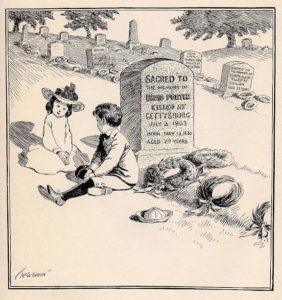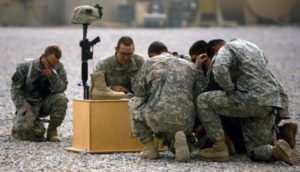When I was a boy in Ohio, we called it Decoration Day. There was a parade, sponsored since 1920 by the local American Legion post, for which – until I was about 7 years old – I dressed up in remnants of my father’s WWII uniforms and marched. Those items were supplemented by some military surplus gear we purchased at an Army-Navy store, although that had been acquired to suit up the neighborhood boys for a July 4th re-enactment of the flag-raising at Iwo Jima. But I had the stuff and I wore it on Decoration Day, although I don’t believe I ever wore any of my dad’s decorations: his service ribbons from his time in the Pacific, before and after the Invasion of Okinawa.
The decorations that gave the holiday its first name actually referred to the bunting and flowers placed by Pennsylvania women on the graves of the dead at Gettysburg in 1864; that too was on July 4th, and there are claimants in Virginia and Georgia who say the practice began there – in 1861 and 1862 respectively. But it appears to be the Gettysburg outing that began the annual practice nationally. The celebration that garnered the most publicity, however, happened in Charleston, South Carolina, where on May Day 1865 a group of former slaves organized a combination cleanup and remembrance of the graves of Union prisoners of war. Ten thousand people came, as did members of the press, whose stories made the event national news.

As Yale scholar David W. Blight writes:
This was the first Memorial Day. African Americans invented Memorial Day in Charleston, South Carolina. What you have there is black Americans recently freed from slavery announcing to the world with their flowers, their feet, and their songs what the war had been about. What they basically were creating was the Independence Day of a Second American Revolution.
Still, if the U.S. Congress is to be believed (no snickering, please), Waterloo, New York is where it all began, in 1866. Maybe.
In 1868, General John A. Logan, Commander-in-Chief of the Grand Army of the Republic (precursor of the American Legion), officially declared May 30th as Decoration Day. Logan had been with Grant at Vicksburg and had served on Sherman’s staff, just to mention two other Ohioans.
The holiday took off – as how could it not, given the devastating losses in the Civil War – and it soon became a day of speeches and picnics and parades, the oldest of which began in ’68 in Ironton, (ahem) Ohio: the Ironton-Lawrence County Memorial Day Parade. (Ironton is the birthplace of Marion Tinsley, 1927-1995, a mathematician “widely considered to be the greatest checkers player who ever lived.” Maybe.)
Folks in Doylestown, Pennsylvania say they had a parade in 1867, but I’ll have to overrule that, since it came before General Logan’s proclamation, although the Keystone State does share a border with the Buckeye State.

The name change to Memorial Day began in the 1880s but didn’t become official until 1967 when the Feds stepped in and it was chiseled in stone a year later by the Uniform Monday Holiday Act. Even Monday has a uniform!
Okay, so far I’ve been chipper as befits a three-day weekend, but it’s important to recall – amidst speeches and barbecues and parades and war films on Turner Classic Movies – that today we are not celebrating either my son (an Army “cavalry” captain and veteran of the Iraq War) or my late father (an Army Airborne lieutenant), because their day is Veteran’s Day, which is always November 11. They came home alive (and well, I’m happy to say).
No, today we remember the soldiers, Marines, sailors, and airmen (and women) who were killed in service to America – and humankind.
Today my wife and I will go to the parade down the main street of the suburban New York town, just north of NYC, where we now live, and we’ll cheer the contingents of sailors or Marines who come into the area during Fleet Week, and we’ll wave to the vets who’ll march too, along with the bands and the Scouts (Boy and Girl), and we’ll be there even if, as predicted, it rains.
I rather like it when there’s bad weather because the rain somewhat disguises my tears, which I never fail to shed, although I never used to cry.

But in 1985 my bride and I visited the Normandy American Cemetery in France, and I defy any living American to walk there among the crosses and Stars of David and not be moved to tears, especially when you come upon a grave marker designated: HERE RESTS IN HONORED GLORY A COMRADE IN ARMS KNOWN BUT TO GOD. We don’t know his name. God does.
Say a prayer for the fallen today. Just a simple thank-you for those who gave, as Mr. Lincoln said at Gettysburg in 1863, “the last full measure of devotion.” And, if you are the least bit cynical about either American adventurism or isolationism (and who is not?), consider the reverent words of General Mark W. Clark inscribed on a wall in the Visitor’s Center at that Normandy cemetery:
If ever proof were needed that we fought for a cause and not for a conquest it could be found in these cemeteries. Here was our only conquest: All we asked. . .was enough soil in which to bury our gallant dead.
















